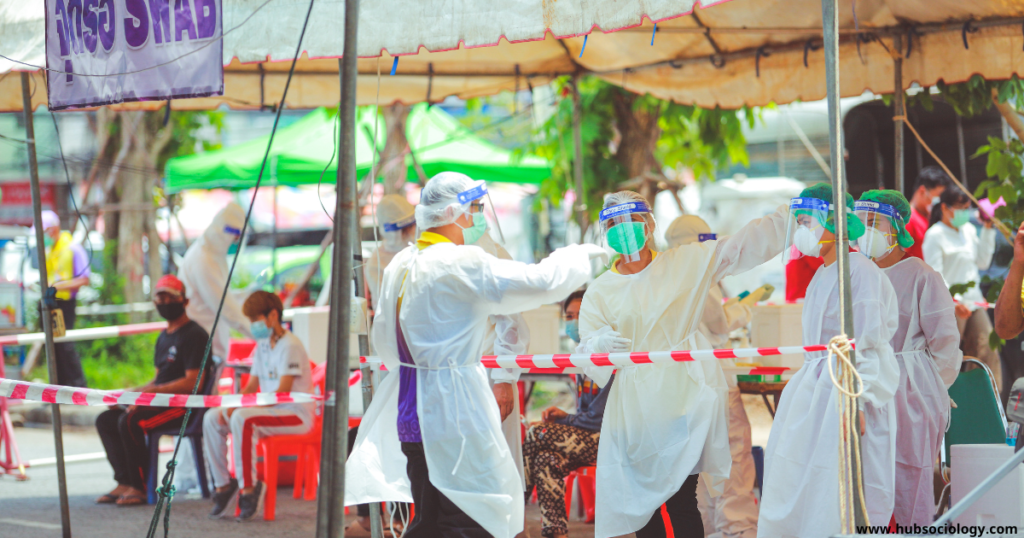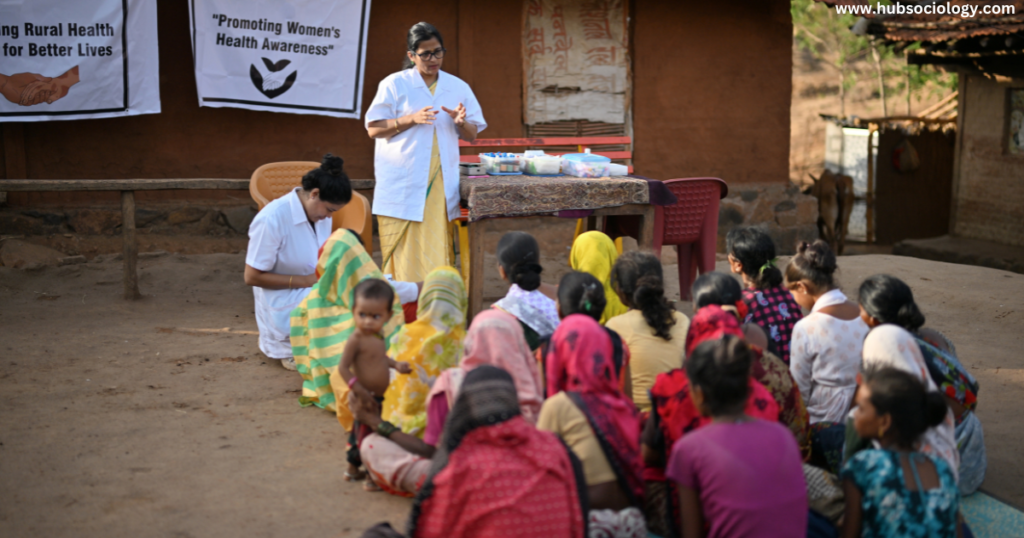Introduction

The Millennium Development Goals (MDGs), adopted by the United Nations in 2000, represented a historic global commitment to addressing pressing development challenges, including poverty, education, gender inequality, and health disparities. While the MDGs encompassed eight broad objectives, their health-related targets were particularly significant because health is both a determinant and an outcome of social development. From a sociological perspective, health cannot be understood in isolation; it is deeply embedded in social structures, cultural norms, economic policies, and political systems.
This article provides a comprehensive sociological analysis of the health-related Millennium Development Goals (MDGs), examining how social determinants of health, institutional frameworks, global inequalities, and grassroots movements shaped their implementation and outcomes. It also critically evaluates the successes and limitations of the MDGs, drawing lessons for contemporary global health initiatives, particularly the Sustainable Development Goals (SDGs).
Health-Related MDGs: A Closer Look
Three of the eight Millennium Development Goals (MDGs) explicitly targeted health improvements:
- MDG 4: Reduce Child Mortality – Aimed at reducing the under-five mortality rate by two-thirds between 1990 and 2015.
- MDG 5: Improve Maternal Health – Sought to reduce maternal mortality by 75% and achieve universal access to reproductive healthcare.
- MDG 6: Combat HIV/AIDS, Malaria, and Other Diseases – Focused on halting and reversing the spread of these diseases.
Additionally, health was indirectly linked to other MDGs, such as MDG 1 (Poverty and Hunger Reduction), since malnutrition exacerbates disease susceptibility, and MDG 3 (Gender Equality), given the strong correlation between women’s empowerment and health outcomes.
Sociological Analysis of Health-Related MDGs
1. Social Determinants of Health: Beyond Biomedical Models
The biomedical model, which views health purely through a clinical lens, fails to account for the broader social, economic, and political factors that shape health outcomes. Sociologists emphasize the social determinants of health, which include:
- Economic Inequality: Poverty restricts access to healthcare, nutritious food, clean water, and sanitation. In low-income countries, high child mortality rates (MDG 4) were often linked to malnutrition and preventable diseases like diarrhea and pneumonia.
- Gender Disparities: Maternal health (MDG 5) was heavily influenced by gender inequalities. In many societies, women’s lack of autonomy over reproductive decisions, early marriages, and limited education contributed to high maternal mortality rates.
- Urban-Rural Divide: Rural populations frequently had worse health outcomes due to fewer healthcare facilities, longer travel distances to clinics, and poorer infrastructure.
- Education and Health Literacy: Educated mothers were more likely to seek prenatal care, vaccinate their children, and adopt hygienic practices, directly impacting MDG 4 and MDG 5.
2. The Role of Social Institutions in Shaping Health Outcomes
Social institutions—such as family, education, religion, and government—played a crucial role in either advancing or hindering health-related Millennium Development Goals (MDGs).
- Healthcare Systems: Weak public health infrastructure in many developing countries limited progress. In some cases, privatization of healthcare exacerbated inequalities by making services inaccessible to the poor.
- Education Systems: Maternal education was one of the strongest predictors of child survival rates. Studies showed that each additional year of a mother’s education reduced child mortality by approximately 5-10%.
- Religion and Cultural Norms: In some regions, religious beliefs discouraged contraceptive use or vaccinations, affecting MDG 5 (maternal health) and MDG 6 (disease control). Conversely, faith-based organizations sometimes played positive roles in health advocacy.
- Government Policies: Countries with strong public health policies (e.g., free maternal healthcare, immunization campaigns) saw faster progress. However, neoliberal economic policies in the 1980s-90s had previously weakened health systems through austerity measures.
3. Global Power Dynamics and Health Inequities
The Millennium Development Goals (MDGs) were a global initiative, but their implementation was shaped by structural inequalities between high-income and low-income nations.
- Pharmaceutical Access: Patent laws under the WTO’s TRIPS agreement restricted access to affordable HIV/AIDS medications (MDG 6), particularly in sub-Saharan Africa. Activist movements, such as those led by South Africa’s Treatment Action Campaign, were instrumental in challenging these barriers.
- Foreign Aid and Dependency: Many low-income countries relied on donor funding for health programs, which sometimes led to vertical interventions (disease-specific programs) rather than horizontal strengthening of health systems.
- Neoliberalism and Structural Adjustment: In the 1980s-90s, Structural Adjustment Programs (SAPs) imposed by the IMF and World Bank forced cuts in public health spending, worsening health disparities before the MDGs were introduced.
4. Grassroots Movements and Community Agency
While global policies set the framework, local activism and community participation were critical in driving health improvements.

- HIV/AIDS Activism: Civil society groups, including networks of people living with HIV, pressured governments to expand antiretroviral therapy (ART) access. Brazil’s successful HIV/AIDS program, which combined government action and activist engagement, became a global model.
- Women’s Health Advocacy: Feminist organizations campaigned for maternal healthcare rights, leading to policy reforms in countries like Nepal and Rwanda.
- Community Health Workers (CHWs): In regions with weak health infrastructure, CHWs played a vital role in delivering vaccinations (MDG 4), promoting maternal care (MDG 5), and distributing bed nets to combat malaria (MDG 6).
Successes and Criticisms of the Health-Related Millennium Development Goals (MDGs)
Key Achievements
- Child Mortality Reduction: Under-five deaths declined from 12.7 million in 1990 to 6 million in 2015, though the two-thirds reduction target was not fully met.
- Progress Against HIV/AIDS: New HIV infections fell by 40% between 2000 and 2013, and ART access expanded dramatically.
- Maternal Health Improvements: Maternal mortality decreased by 45%, falling short of the 75% target but still saving millions of lives.
Sociological Critiques
- Top-Down Approach: The MDGs were often donor-driven, with limited input from local communities. This led to one-size-fits-all interventions that ignored cultural and regional nuances.
- Measurement Limitations: National averages masked disparities—rural, poor, and marginalized groups saw slower progress. For example, while urban child mortality rates improved, remote areas lagged behind.
- Neglect of Non-Communicable Diseases (NCDs): The focus on infectious diseases (MDG 6) overlooked the growing burden of diabetes, hypertension, and mental health disorders.
- Short-Termism: Many programs prioritized immediate outcomes (e.g., vaccination campaigns) over long-term health system strengthening.
Lessons for the Sustainable Development Goals (SDGs)
The SDGs (2015-2030) sought to address some of the MDGs’ shortcomings by adopting a more holistic, equity-focused approach. Key lessons include:
- Universal Health Coverage (UHC): SDG 3 emphasizes health systems strengthening rather than disease-specific programs.
- Intersectional Equity: The SDGs explicitly target gender, economic, and geographic disparities in health access.
- Local Participation: Future initiatives must engage communities in policymaking to ensure culturally appropriate interventions.
- Addressing Structural Drivers: Tackling poverty, education, and gender inequality remains essential for sustainable health improvements.
Conclusion: Health as a Social Justice Issue
The MDGs demonstrated that health is not just a medical issue but a social one. While significant progress was made, the structural roots of health inequities—poverty, gender discrimination, and global inequality—persist.
Moving forward, sociologists argue that health policies must be integrated with broader social justice movements. Only by addressing systemic inequalities can we achieve truly equitable and sustainable health outcomes in the post-2030 agenda.

Topic Related Questions
5-Mark Questions (Short Answer)
- List the three health-related Millennium Development Goals (MDGs) and their primary targets.
- Define “social determinants of health” and give two examples relevant to the MDGs.
- How did gender inequality impact maternal health (MDG 5) outcomes?
- What role did community health workers (CHWs) play in achieving the MDGs?
- Why was the reduction in HIV/AIDS infections (MDG 6) considered a partial success?
- Name two criticisms of the Millennium Development Goals (MDGs) from a sociological perspective.
- How did Structural Adjustment Programs (SAPs) affect health systems before the MDGs?
- What is the significance of maternal education in reducing child mortality (MDG 4)?
- How did pharmaceutical patent laws impact access to HIV/AIDS treatment?
- What is the difference between “vertical” and “horizontal” health interventions in the MDGs?
10-Mark Questions (Brief Essay/Detailed Response)
- Discuss how economic inequality influenced the success of health-related Millennium Development Goals (MDGs).
- Explain the role of social institutions (family, education, religion) in shaping health outcomes under the Millennium Development Goals (MDGs).
- Analyze the impact of globalization and foreign aid on the implementation of MDG health targets.
- How did grassroots movements contribute to progress in combating HIV/AIDS (MDG 6)?
- Compare the top-down approach of the Millennium Development Goals (MDGs) with the need for community participation in health interventions.
- Why did maternal health (MDG 5) show improvement but fail to meet its 75% reduction target?
- Evaluate the strengths and weaknesses of disease-specific (vertical) programs under MDG 6.
- How did the urban-rural divide affect progress in child mortality reduction (MDG 4)?
- Discuss the limitations of measuring health progress through national averages in the MDGs.
- What lessons from the Millennium Development Goals (MDGs) were incorporated into the Sustainable Development Goals (SDGs)?
15-Mark Questions (Comprehensive Essay/Critical Analysis)
- Critically examine the sociological factors that contributed to the successes and failures of the health-related Millennium Development Goals (MDGs).
- “Health is not just a medical issue but a social justice issue.” Discuss this statement in the context of the Millennium Development Goals (MDGs).
- How did neoliberal economic policies (e.g., Structural Adjustment Programs) undermine health systems before the Millennium Development Goals (MDGs), and what were the long-term consequences?
- Analyze the role of gender, class, and geography in shaping unequal health outcomes under the MDGs.
- Compare the Millennium Development Goals (MDGs) and SDGs in terms of their approach to health equity. Which framework is more effective from a sociological perspective?
- “The Millennium Development Goals (MDGs) prioritized infectious diseases over non-communicable diseases (NCDs), leaving a critical gap in global health.” Critically evaluate this statement.
- How did power dynamics between high-income and low-income countries influence the implementation of health-related Millennium Development Goals (MDGs)?
- Discuss the importance of community participation versus top-down policymaking in achieving sustainable health improvements.
- To what extent did cultural and religious beliefs act as barriers or facilitators to health-related MDGs?
- “The Millennium Development Goals (MDGs) were a step forward but failed to address structural inequalities.” Do you agree? Justify your answer with sociological evidence.
Additional Discussion Questions for Classroom Debates
- Did the MDGs rely too much on quantitative targets rather than qualitative improvements in health systems?
- Were the health-related MDGs more beneficial to urban populations than rural ones?
- How can future global health initiatives avoid the pitfalls of the MDGs?
- Should pharmaceutical companies be held accountable for limiting access to essential medicines in developing countries?
